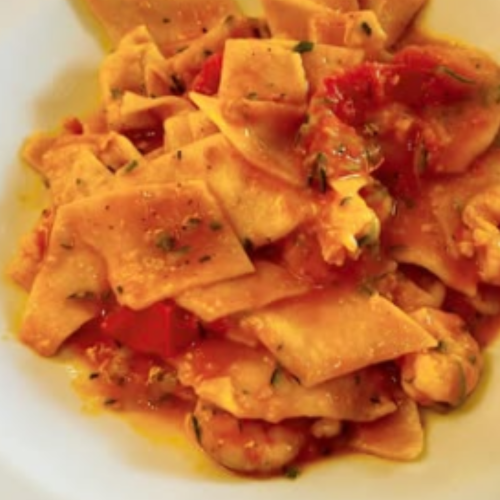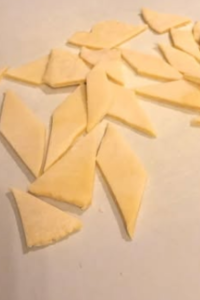Method:
Make the Dough:
On a clean surface, mix the flour and salt together.
Make a well in the center and add the eggs.
Gradually mix the eggs into the flour using a fork, then knead the mixture into a smooth dough. If it’s too dry, add a small amount of water, but the dough should be firm and slightly elastic.
Knead for 10 minutes until smooth. Wrap it in plastic wrap and let it rest for at least 30 minutes.
Roll Out the Dough:
Once the dough has rested, divide it into portions and roll each portion out to about 2mm thick (you can use a rolling pin or pasta machine). The key here is to make the dough as thin as possible without tearing.
Cut the Pasta:
Use a knife or a pasta cutter to create irregular shapes. You can make squares, rectangles, or strips, however you like, as the charm of maltagliati lies in the rough, uneven shapes.
Cook the Pasta:
Bring a large pot of salted water to a boil. Gently add the maltagliati and cook until they rise to the surface, about 3-5 minutes. Since the pieces vary in size, check them for doneness by tasting.
Serve:
Drain the pasta using a slotted spoon and toss it in your favorite sauce. A rich tomato sauce, a simple sage butter, or a vegetable-based sauce works beautifully with maltagliati. You can also serve it in soups, as many Italians do.
Tips and Variations:
Vegan version: Simply substitute the eggs with water and a bit of olive oil. It will make the dough slightly more elastic.
Gluten-Free: You can use a gluten-free flour blend, but keep in mind the texture may differ.
Sauce Pairings: Maltagliati pairs well with almost any sauce. For a hearty meal, use ragù or a vegetable-heavy sauce.

